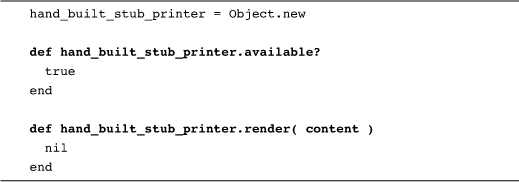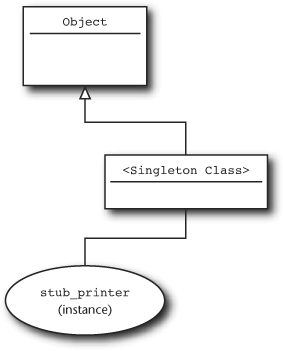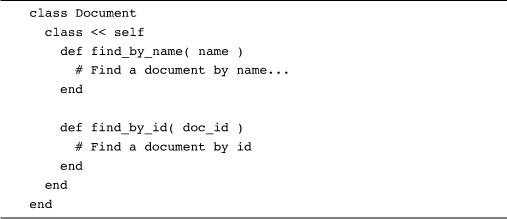Chapter 13. Get the Behavior You Need with Singleton and Class Methods
Much of programming is about building models of the world. Social networking systems model the relationships between people. Accounting systems model the flow of money. Flight simulations model airplanes in flight (or slamming into the ground if I’m at the controls). You can, in fact, look at all of object oriented programming as a support system for this kind of modeling. We build classes to describe groups of similar things, and we have instances to represent the things themselves.
Usually, the class/instance approximation works fine: You define a class called American, and you define methods that indicate instances of this class like hamburgers and baseball. The problem is that the class/instance approximation is exactly that, an approximation. I am, for example, an American who does indeed like the occasional burger, but I can’t tell you the last time I willingly sat through a baseball game.
What do you do when the central approximation of object oriented programming breaks down, when your instance does not want to follow the rules laid down by its class? In this chapter we will look at Ruby’s answer to this question: the singleton method. We will see how singleton methods allow you to produce objects with an independent streak, objects whose behavior is not completely controlled by their class. We will also see how class methods are actually just singleton methods by another name.
A Stubby Puzzle
Let’s start with a question. Recall that back in Chapter 9 we saw how RSpec made it easy to create stub objects, those stand-ins for real objects that make writing tests less of a pain. We saw that if, inside of a spec, you did something like this:
stub_printer = stub :available? => true, :render => nil
You would end up, in the form of stub_printer, with an object having two methods, available? and render:
![]()
We also saw in Chapter 9 that RSpec doesn’t limit you to one stub object at a time, so you could easily conjure up a second stub, perhaps for a font:
stub_font = stub :size => 14, :name => 'Courier'
Now for the question: If you look at the classes of these two stub objects:
![]()
You will discover that they are one and the same:
![]()
How is this possible? After all, the printer object supports different methods than the font object. How could they both be of the same class?
The answer is that the available? and render methods on the printer instance, as well as the size and name methods on the font instance, are singleton methods. In Ruby, a singleton method is a method that is defined for exactly one object instance.1 It’s as though Ruby objects can declare independence from their class and say, “Yeah, I know that no other Spec::Mocks::Mock instance has an available? method, but I’m special.”
You can hang a singleton method on just about any object at any time.2 The mechanics of defining singleton methods are really pretty simple: Instead of saying def method_name as you would to define a regular garden-variety method, you define a singleton method with def instance.method_name. If, for example, you wanted to create your own stub printer by hand, you could say this:

You could then call hand_built_stub_printer.available? and render. Singleton methods are in all respects ordinary methods: They can accept arguments, return values, and do anything else that a regular method can do. The only difference is that singleton methods are stuck to a single object instance.
Singleton methods override any regular, class-defined methods. For example, if you run the (admittedly more fun than useful) code shown here:

I'm not telling
There is also an alternative syntax for defining singleton methods, one that can be less bulky if you are creating a lot of methods:

Either way you say it, you end up with the same singleton methods.
A Hidden, but Real Class
So how does Ruby pull off the singleton method trick? The key is that every Ruby object carries around an additional, somewhat shadowy class of its own. As you can see in Figure 13-1, this more or less secret class—the singleton class—sits between every object and its regular class.3 The singleton class starts out as just a methodless shell and is therefore pretty invisible.4 It’s only when you add something to it that the singleton class steps out of the shadows and makes its existence felt.
Figure 13-1 The singleton class

Since it sits directly above the instance, the singleton class has the first say on how the object is going to behave, which is why methods defined in the singleton class will win out over methods defined in the object’s regular class, and in the superclasses.
Don’t think that the singleton class is just a convenient fiction, either. There really is an actual Ruby class hidden in there. You can even get hold of the singleton class, like this:

The code shown here may look bizarre, but it is straightforward: When you do the class << hand_built_stub_printer, you change context so that self is the singleton class. Since class definitions, like most Ruby expressions, return the last thing they evaluate, simply sticking self inside the class definition causes the whole class statement to return the singleton class.
Class Methods: Singletons in Plain Sight
A common programmer reaction when bumping into singleton methods for the first time is to dismiss them as an interesting but mostly useless feature. After all, outside of a few specialized cases such as stubs and mocks, why bother building classes of consistent behavior only to override that behavior with a singleton method? In fact, this sensible, pragmatic assessment turns out to be completely mistaken. There is one particular application of singleton methods that is so pervasive that it is practically impossible to build a Ruby program without it. We even have a special name for these ubiquitous singleton methods, class methods.
To see how class methods are actually singleton methods in disguise, let’s build another singleton method, this time one that prints out some interesting information about its host object:

Run the code above and you will get output that looks something like this:
![]()
No surprise here, we are just traveling over ground that we covered earlier. Next, however, comes the twist: What if, instead of an instance of Document, we defined the explain method on the Document class itself?

Do that and you will get the following output:
![]()
Since my_object is just a reference to Document, we can also call the explain method like this:
Document.explain
We can also define the explain method on Document explicitly:

If the code above looks familiar, it should, since it is a typical Ruby class method definition. It is also a singleton method definition! If you think about it, this all makes sense: Any given class, say, Document, is an instance of Class. This means that it inherits all kinds of methods from Class, methods like name and superclass. When we want to add a class method, we want that new method to exist only on the one class (Document in the example), not on all classes. Since the object that goes by the name of Document is an instance of Class, we need to create a method that exists only on the one object (Document) and not on any of the other instances of the same class. What we need is a singleton method.
Once you get used to the idea that a class method is just a singleton method on an instance of Class, a lot of things that you learned in Ruby 101 start to make sense. For example, you will sometimes see the following syntax used to define class methods:

This code only makes sense in light of the class method = singleton method equation: It is simply the class << some_object syntax applied to the Document class.
In the Wild
Class methods abound in real Ruby programs. Class methods are the perfect home for the code that is related to a class but independent of any given instance of the class. For example, we’ve seen that each ActiveRecord model class is associated with a particular table in the database. So that if you had this:
![]()
You would have a class that is associated with a database table. Which table? For that, you need to ask the class, not an instance:
my_table_name = Author.table_name
A common use for class methods is to provide alternative methods for constructing new instances. The Ruby library Date class, for example, comes with a whole raft of class methods that create new instances. You can, for example, get a date from the year, the month, and the day:
![]()
Or by the year and the day of that year:
xmas = Date.ordinal( 2010, 359 )
Or by the day, the week number, and the day of the week:
xmas = Date.commercial( 2010, 51, 6 )
If you have many different ways that you might create an object, a set of well-named class methods is generally clearer than making the user supply all sorts of clever arguments to the new method.
Plain, nonclass singleton methods are as rare as class methods are common. In fact, their main use in real code is the one we explored earlier in this chapter, building mocks and stubs for testing frameworks. Both RSpec and the Mocha framework that we looked at briefly in Chapter 9 use singleton methods to do their mocking magic. But don’t take my word for it, look for yourself:

This RSpec example creates our familiar stubbed-out printer and then uses singleton_methods—part of the arsenal of every Ruby object—to print out a list of the names of all of the singleton methods. Run this spec and you will see:
[:available?, :render]
If you do the same kind of thing with the mocks and stubs created by the Mocha gem, you will discover that they too rely on singleton methods.
Staying Out of Trouble
Most of the problems you are likely to encounter with singleton methods, particularly in their role as class methods, will likely stem from simple confusion. Easiest to deal with is confusion over scope. Remember, when you define a class method, it is a method attached to a class. The instances of the class will not know anything about that method. Thus, if you define a class method on Document:
Then you can call that method via the class:
book = Document.create_test_document( 10000 )
But Document instances are completely ignorant of the Document class methods, so that this:
longer_doc = book.create_test_document( 20000 )
Will give you this:
![]()
Well, perhaps not completely ignorant, since instances do know all about their classes:
longer_doc = book.class.create_test_document( 20000 )
A bit more subtle is the confusion over the value of self during the execution of a class method when you mix classes, subclasses, and class methods. To see what I mean, consider this simple pair of classes:

Now, clearly, if you run Parent.who_am_i you would expect the following output:
The value of self is Parent
But what happens if you run Child.who_am_i? The answer is that self is always the thing before the period when you called the class method:
The value of self is Child
While this behavior can be a bit unsettling, it is actually the secret behind some very powerful Ruby metaprogramming techniques, techniques that we will take up in Chapter 26.
Wrapping Up
In this chapter we took a tour of singleton methods and learned how they work. We saw that singleton methods are great for those times when you need an object with some unique behavior. We saw that singleton methods are hidden inside the more or less secret singleton class that is part of most Ruby objects. We saw that the singleton class is a real class, one that you can actually get hold of. We saw how singleton methods can really shine in testing, where they make it easy to construct stub and mock objects. But we also saw that the most common use of singleton methods is for class methods, which are just singleton methods defined on the instances of Class.

